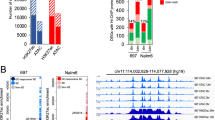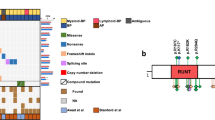Abstract
Successful treatment results for MLL-rearranged Acute Lymphoblastic Leukemia (ALL) in infants remain difficult to achieve. Significantly contributing to therapy failure is poor response to glucocorticoids (GCs), like prednisone. Thus, overcoming resistance to these drugs may be a crucial step towards improving prognosis. We defined a gene signature that accurately discriminates between prednisolone-resistant and prednisolone-sensitive MLL-rearranged infant ALL patient samples. In the current study, we applied Connectivity Map analysis to perform an in silico screening for agents capable of reversing the prednisolone-resistance profile and induce sensitivity. These analyses revealed that LY294002, a PI3K inhibitor, would potentially fulfill this task. Subsequent validation experiments demonstrated that indeed LY294002, and other known PI3K inhibitors, markedly sensitized otherwise resistant MLL-rearranged ALL cells to prednisolone in vitro. Using quantitative RT-PCR analyses, we validated the modulating effects of the PI3K inhibitors on the expression of the genes present in our prednisolone-resistance profile. Interestingly, prednisolone-sensitizing actions may be mediated by inhibition of FCGR1B. Moreover, only high-level expression of FCGR1B showed to be predictive for a poor prognosis and shRNA-mediated knock-down of FCGR1B led to in vitro prednisolone sensitization. Thus, implementing FDA-approved PI3K inhibitors in current treatments may potentially improve the GC response and prognosis in patients with MLL-rearranged ALL.
This is a preview of subscription content, access via your institution
Access options
Subscribe to this journal
Receive 12 print issues and online access
$259.00 per year
only $21.58 per issue
Buy this article
- Purchase on Springer Link
- Instant access to full article PDF
Prices may be subject to local taxes which are calculated during checkout






Similar content being viewed by others
References
Greaves MF . Infant leukaemia biology, aetiology and treatment. Leukemia 1996; 10: 372–377.
Pieters R, Schrappe M, De Lorenzo P, Hann I, De Rossi G, Felice M et al. A treatment protocol for infants younger than 1 year with acute lymphoblastic leukaemia (Interfant-99): an observational study and a multicentre randomised trial. Lancet 2007; 370: 240–250.
Pui CH, Relling MV, Downing JR . Acute lymphoblastic leukemia. N Engl J Med 2004; 350: 1535–1548.
Pieters R, den Boer ML, Durian M, Janka G, Schmiegelow K, Kaspers GJ et al. Relation between age, immunophenotype and in vitro drug resistance in 395 children with acute lymphoblastic leukemia—implications for treatment of infants. Leukemia 1998; 12: 1344–1348.
Dordelmann M, Reiter A, Borkhardt A, Ludwig WD, Gotz N, Viehmann S et al. Prednisone response is the strongest predictor of treatment outcome in infant acute lymphoblastic leukemia. Blood 1999; 94: 1209–1217.
Frankel LS, Ochs J, Shuster JJ, Dubowy R, Bowman WP, Hockenberry-Eaton M et al. Therapeutic trial for infant acute lymphoblastic leukemia: the Pediatric Oncology Group experience (POG 8493). J Pediatr Hematol Oncol 1997; 19: 35–42.
Reaman GH, Sposto R, Sensel MG, Lange BJ, Feusner JH, Heerema NA et al. Treatment outcome and prognostic factors for infants with acute lymphoblastic leukemia treated on two consecutive trials of the Children's Cancer Group. J Clin Oncol 1999; 17: 445–455.
Den Boer ML, Harms DO, Pieters R, Kazemier KM, Gobel U, Korholz D et al. Patient stratification based on prednisolone-vincristine-asparaginase resistance profiles in children with acute lymphoblastic leukemia. J Clin Oncol 2003; 21: 3262–3268.
Kaspers GJ, Veerman AJ, Pieters R, Van Zantwijk CH, Smets LA, Van Wering ER et al. In vitro cellular drug resistance and prognosis in newly diagnosed childhood acute lymphoblastic leukemia. Blood 1997; 90: 2723–2729.
Holleman A, Cheok MH, den Boer ML, Yang W, Veerman AJ, Kazemier KM et al. Gene-expression patterns in drug-resistant acute lymphoblastic leukemia cells and response to treatment. N Engl J Med 2004; 351: 533–542.
Wei G, Twomey D, Lamb J, Schlis K, Agarwal J, Stam RW et al. Gene expression-based chemical genomics identifies rapamycin as a modulator of MCL1 and glucocorticoid resistance. Cancer Cell 2006; 10: 331–342.
Lamb J, Crawford ED, Peck D, Modell JW, Blat IC, Wrobel MJ et al. The Connectivity Map: using gene-expression signatures to connect small molecules, genes, and disease. Science 2006; 313: 1929–1935.
Lamb J . The Connectivity Map: a new tool for biomedical research. Nat Rev Cancer 2007; 7: 54–60.
Stam RW, Den Boer ML, Schneider P, de Boer J, Hagelstein J, Valsecchi MG et al. Association of high-level MCL-1 expression with in vitro and in vivo prednisone resistance in MLL-rearranged infant acute lymphoblastic leukemia. Blood 2010; 115: 1018–1025.
Yeoh EJ, Ross ME, Shurtleff SA, Williams WK, Patel D, Mahfouz R et al. Classification, subtype discovery, and prediction of outcome in pediatric acute lymphoblastic leukemia by gene expression profiling. Cancer Cell 2002; 1: 133–143.
Armstrong SA, Staunton JE, Silverman LB, Pieters R, den Boer ML, Minden MD et al. MLL translocations specify a distinct gene expression profile that distinguishes a unique leukemia. Nat Genet 2002; 30: 41–47.
Stam RW, Schneider P, Hagelstein JA, van der Linden MH, Stumpel DJ, de Menezes RX et al. Gene expression profiling-based dissection of MLL translocated and MLL germline acute lymphoblastic leukemia in infants. Blood 2010; 115: 2835–2844.
Spijkers-Hagelstein JA, Mimoso Pinhancos S, Schneider P, Pieters R, Stam RW . Src kinase-induced phosphorylation of annexin A2 mediates glucocorticoid resistance in MLL-rearranged infant acute lymphoblastic leukemia. Leukemia 2012; 27: 1063–1071.
Kaspers GJ, Veerman AJ, Pieters R, Broekema GJ, Huismans DR, Kazemier KM et al. Mononuclear cells contaminating acute lymphoblastic leukaemic samples tested for cellular drug resistance using the methyl-thiazol-tetrazolium assay. Br J Cancer 1994; 70: 1047–1052.
Pieters R, Loonen AH, Huismans DR, Broekema GJ, Dirven MW, Heyenbrok MW et al. In vitro drug sensitivity of cells from children with leukemia using the MTT assay with improved culture conditions. Blood 1990; 76: 2327–2336.
Berenbaum MC . Synergy, additivism and antagonism in immunosuppression. A critical review. Clin Exp Immunol 1977; 28: 1–18.
Ramakers-van Woerden NL, Beverloo HB, Veerman AJ, Camitta BM, Loonen AH, van Wering ER et al. In vitro drug-resistance profile in infant acute lymphoblastic leukemia in relation to age, MLL rearrangements and immunophenotype. Leukemia 2004; 18: 521–529.
Kong D, Yamori T . Phosphatidylinositol 3-kinase inhibitors: promising drug candidates for cancer therapy. Cancer Sci 2008; 99: 1734–1740.
Workman P, Clarke PA, Raynaud FI, van Montfort RL . Drugging the PI3 kinome: from chemical tools to drugs in the clinic. Cancer Res 2010; 70: 2146–2157.
Munoz L, Nomdedeu JF, Villamor N, Guardia R, Colomer D, Ribera JM et al. Acute myeloid leukemia with MLL rearrangements: clinicobiological features, prognostic impact and value of flow cytometry in the detection of residual leukemic cells. Leukemia 2003; 17: 76–82.
Tur MK, Huhn M, Thepen T, Stocker M, Krohn R, Vogel S et al. Recombinant CD64-specific single chain immunotoxin exhibits specific cytotoxicity against acute myeloid leukemia cells. Cancer Res 2003; 63: 8414–8419.
Zhong RK, van de Winkel JG, Thepen T, Schultz LD . Ball ED Cytotoxicity of anti-CD64-ricin a chain immunotoxin against human acute myeloid leukemia cells in vitro and in SCID mice. J Hematother Stem Cell Res 2001; 10: 95–105.
Marley SB, Lewis JL, Schneider H, Rudd CE, Gordon MY . Phosphatidylinositol-3 kinase inhibitors reproduce the selective antiproliferative effects of imatinib on chronic myeloid leukaemia progenitor cells. Br J Haematol 2004; 125: 500–511.
Grandage VL, Gale RE, Linch DC, Khwaja A . PI3-kinase/Akt is constitutively active in primary acute myeloid leukaemia cells and regulates survival and chemoresistance via NF-kappaB, Mapkinase and p53 pathways. Leukemia 2005; 19: 586–594.
Edwards H, Xie C, LaFiura KM, Dombkowski AA, Buck SA, Boerner JL et al. RUNX1 regulates phosphoinositide 3-kinase/AKT pathway: role in chemotherapy sensitivity in acute megakaryocytic leukemia. Blood 2009; 114: 2744–2752.
Neri LM, Borgatti P, Tazzari PL, Bortul R, Cappellini A, Tabellini G et al. The phosphoinositide 3-kinase/AKT1 pathway involvement in drug and all-trans-retinoic acid resistance of leukemia cells. Mol Cancer Res 2003; 1: 234–246.
Tabellini G, Cappellini A, Tazzari PL, Fala F, Billi AM, Manzoli L et al. Phosphoinositide 3-kinase/Akt involvement in arsenic trioxide resistance of human leukemia cells. J Cell Physiol 2005; 202: 623–634.
O'Gorman DM, McKenna SL, McGahon AJ, Knox KA, Cotter TG. . Sensitisation of HL60 human leukaemic cells to cytotoxic drug-induced apoptosis by inhibition of PI3-kinase survival signals. Leukemia 2000; 14: 14602–14611.
Acknowledgements
The authors gratefully thank all the members and participating hospitals of the INTERFANT-99 study groups for supporting our research by generously providing leukemic samples. This study was funded by KIKA (stichting KinderenKankervrij) (JAPS-H). RWS was financially supported by the Dutch Cancer Society (KWF Kankerbestrijding). The institutions funding this research did not participate in study design, data collection, data analysis, data interpretation or writing of the report. All authors had full access to all the data at all time and shared final responsibility for the decision to submit for publication.
Author information
Authors and Affiliations
Corresponding author
Ethics declarations
Competing interests
The authors declare no conflict of interest.
Additional information
JAPS-H designed and performed research and wrote the paper; SSP and PS performed research; RP and RWS designed and supervised research, wrote and reviewed the paper.
Supplementary Information accompanies this paper on the Leukemia website
Supplementary information
Rights and permissions
About this article
Cite this article
Spijkers-Hagelstein, J., Pinhanços, S., Schneider, P. et al. Chemical genomic screening identifies LY294002 as a modulator of glucocorticoid resistance in MLL-rearranged infant ALL. Leukemia 28, 761–769 (2014). https://doi.org/10.1038/leu.2013.245
Received:
Revised:
Accepted:
Published:
Issue Date:
DOI: https://doi.org/10.1038/leu.2013.245
Keywords
This article is cited by
-
Modelling acquired resistance to DOT1L inhibition exhibits the adaptive potential of KMT2A-rearranged acute lymphoblastic leukemia
Experimental Hematology & Oncology (2023)
-
Combination of the PI3K inhibitor Idelalisib with the conventional cytostatics cytarabine and dexamethasone leads to changes in pathway activation that induce anti-proliferative effects in B lymphoblastic leukaemia cell lines
Cancer Cell International (2020)
-
Differential network analysis and protein-protein interaction study reveals active protein modules in glucocorticoid resistance for infant acute lymphoblastic leukemia
Molecular Medicine (2019)
-
The histone deacetylase inhibitor givinostat (ITF2357) exhibits potent anti-tumor activity against CRLF2-rearranged BCP-ALL
Leukemia (2017)
-
Network-based expression analysis reveals key genes related to glucocorticoid resistance in infant acute lymphoblastic leukemia
Cellular Oncology (2017)



